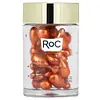What's inside
What's inside
 Key Ingredients
Key Ingredients

 Benefits
Benefits

 Concerns
Concerns

No concerns
 Ingredients Side-by-side
Ingredients Side-by-side

Dimethicone
EmollientAscorbic Acid
AntioxidantTrisiloxane
Skin ConditioningDimethiconol
EmollientSilica Dimethyl Silylate
EmollientTroxerutin
Skin ConditioningRubus Idaeus Leaf Cell Culture
Skin ConditioningPolygonum Aviculare Extract
EmollientTerminalia Ferdinandiana Fruit Extract
AntioxidantWater
Skin ConditioningCaprylic/Capric Triglyceride
MaskingDiethylhexyl Syringylidenemalonate
Skin ProtectingGlycerin
HumectantPotassium Sorbate
PreservativeSodium Benzoate
MaskingDimethicone, Ascorbic Acid, Trisiloxane, Dimethiconol, Silica Dimethyl Silylate, Troxerutin, Rubus Idaeus Leaf Cell Culture, Polygonum Aviculare Extract, Terminalia Ferdinandiana Fruit Extract, Water, Caprylic/Capric Triglyceride, Diethylhexyl Syringylidenemalonate, Glycerin, Potassium Sorbate, Sodium Benzoate
Water
Skin ConditioningPropanediol
SolventPPG-24-Glycereth-24
EmulsifyingGlycerin
Humectant3-O-Ethyl Ascorbic Acid
Skin ConditioningTroxerutin
Skin ConditioningCistus Incanus Flower/Leaf/Stem Extract
Skin ConditioningNonapeptide-1
Skin ConditioningPolygonum Aviculare Extract
EmollientTerminalia Ferdinandiana Fruit Extract
AntioxidantPEG-40 Hydrogenated Castor Oil
EmulsifyingSodium Polyacryloyldimethyl Taurate
Emulsion StabilisingPPG-26-Buteth-26
Skin ConditioningMaltodextrin
AbsorbentCaprylyl Glycol
EmollientPotassium Sorbate
PreservativeSodium Phosphate
BufferingSodium Benzoate
Masking1,2-Hexanediol
Skin ConditioningTetrasodium EDTA
Disodium Phosphate
BufferingCitric Acid
BufferingCaprylhydroxamic Acid
Parfum
MaskingLimonene
PerfumingLinalool
PerfumingCitral
PerfumingCI 15985
Cosmetic ColorantWater, Propanediol, PPG-24-Glycereth-24, Glycerin, 3-O-Ethyl Ascorbic Acid, Troxerutin, Cistus Incanus Flower/Leaf/Stem Extract, Nonapeptide-1, Polygonum Aviculare Extract, Terminalia Ferdinandiana Fruit Extract, PEG-40 Hydrogenated Castor Oil, Sodium Polyacryloyldimethyl Taurate, PPG-26-Buteth-26, Maltodextrin, Caprylyl Glycol, Potassium Sorbate, Sodium Phosphate, Sodium Benzoate, 1,2-Hexanediol, Tetrasodium EDTA, Disodium Phosphate, Citric Acid, Caprylhydroxamic Acid, Parfum, Limonene, Linalool, Citral, CI 15985
Ingredients Explained
These ingredients are found in both products.
Ingredients higher up in an ingredient list are typically present in a larger amount.
Glycerin is already naturally found in your skin. It helps moisturize and protect your skin.
A study from 2016 found glycerin to be more effective as a humectant than AHAs and hyaluronic acid.
As a humectant, it helps the skin stay hydrated by pulling moisture to your skin. The low molecular weight of glycerin allows it to pull moisture into the deeper layers of your skin.
Hydrated skin improves your skin barrier; Your skin barrier helps protect against irritants and bacteria.
Glycerin has also been found to have antimicrobial and antiviral properties. Due to these properties, glycerin is often used in wound and burn treatments.
In cosmetics, glycerin is usually derived from plants such as soybean or palm. However, it can also be sourced from animals, such as tallow or animal fat.
This ingredient is organic, colorless, odorless, and non-toxic.
Glycerin is the name for this ingredient in American English. British English uses Glycerol/Glycerine.
Learn more about GlycerinWe don't have a description for Polygonum Aviculare Extract yet.
Potassium Sorbate is a preservative used to prevent yeast and mold in products. It is commonly found in both cosmetic and food products.
This ingredient comes from potassium salt derived from sorbic acid. Sorbic acid is a natural antibiotic and effective against fungus.
Both potassium sorbate and sorbic acid can be found in baked goods, cheeses, dried meats, dried fruit, ice cream, pickles, wine, yogurt, and more.
You'll often find this ingredient used with other preservatives.
Learn more about Potassium SorbateSodium Benzoate is a preservative. It's used in both cosmetic and food products to inhibit the growth of mold and bacteria. It is typically produced synthetically.
Both the US FDA and EU Health Committee have approved the use of sodium benzoate. In the US, levels of 0.1% (of the total product) are allowed.
Sodium benzoate works as a preservative by inhibiting the growth of bacteria inside of cells. It prevents the cell from fermenting a type of sugar using an enzyme called phosphofructokinase.
It is the salt of benzoic acid. Foods containing sodium benzoate include soda, salad dressings, condiments, fruit juices, wines, and snack foods.
Studies for using ascorbic acid and sodium benzoate in cosmetics are lacking, especially in skincare routines with multiple steps.
We always recommend speaking with a professional, such as a dermatologist, if you have any concerns.
Learn more about Sodium BenzoateTerminalia Ferdinandiana Fruit Extract is from the Kakadu plum. The Kakadu plum is native to northern Australia. The Kakadu plum holds the record for having the highest amount of natural vitamin C.
This ingredient is an antioxidant. Antioxidants help fight free-radical molecules. Free-radical molecules are capable of damaging our cells and other genetic material. Antioxidants help stabilize free-radicals and thus may reduce the signs of aging.
The high vitamin C content of Kakadu plum also helps lighten skin. Vitamin C has been shown to block the process of skin darkening that leads to hyperpigmentation.
Kakadu plums have been used by indigenous cultures as medicine to help treat colds and as an antiseptic.
Learn more about Terminalia Ferdinandiana Fruit ExtractWe don't have a description for Troxerutin yet.
Water. It's the most common cosmetic ingredient of all. You'll usually see it at the top of ingredient lists, meaning that it makes up the largest part of the product.
So why is it so popular? Water most often acts as a solvent - this means that it helps dissolve other ingredients into the formulation.
You'll also recognize water as that liquid we all need to stay alive. If you see this, drink a glass of water. Stay hydrated!
Learn more about Water